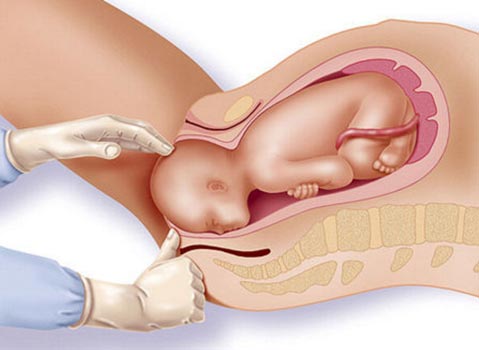What Is Normal delivery?
Normal delivery is a natural process in which the baby is born head-first through the vaginal canal (birth canal). The baby and placenta are delivered from the uterus via the cervix and birth canal. This process is caused by uterine contractions during labour. Most women give birth between 38 and 40 weeks after becoming pregnant. It is the safer option for an infant, and it also increases the possibility that your subsequent pregnancies will be risk-free. Dr. Deepika Hospital is considered one of the most affordable, safest, and Best delivery doctor in Borivali, Kandivali, Dahisar, Mira Road, and surrounding areas.

Normal delivery signs and symptoms
Lightening: When the baby’s head drops into your pelvic area in preparation for delivery, this condition occurs. It can be identified by the fact that the abdomen appears lower and you have less difficulty breathing because the pressure on the diaphragm from beneath is reduced.
Increased Urination: The baby’s head dropping into the pelvis can cause an increased urge to urinate. The head pressurises the urinary bladder, causing women approaching labour to have frequent urges to urinate.
Blood discharge: The baby’s head pressure causes the mucus plug to be expressed from the vagina, sometimes resulting in blood-tinged or brownish discharge from the cervix.
Ruptured Membranes: Fluid leakage from the vagina indicates that the amniotic sac membranes surrounding the baby have ruptured. This can happen before or during labour.
Contractions: Uterine muscle spasms or irregular contractions may occur at less than ten-minute intervals, indicating the onset of labour.
True vs false labour pain
Contraction timing:
False labour occurs when contractions are irregular and do not get closer together.
True labour: contractions occur at regular intervals and become closer together over time. (Contractions last between 30 and 70 seconds.)
Change with movement:
False labour: contractions may stop when you move or rest, or even when you change positions.
True labour: contractions remain despite movement or position change.
What happens during labour?
- A hormone is released by the brain to signal uterine contractions.
- Contractions widen your cervical aperture by ten centimetres.
- Pushing helps your baby move down through the cervix and out.
- Your hormone levels will change during and after delivery.
When to visit the gynecologist? When do you suspect that labour has started?
- Bright red vaginal bleeding
- Continuous leaking of fluid or wetness, or if your amniotic fluid breaks (can be felt as a “gushing” of fluid)
- Strong contractions every five minutes for one hour
- Contractions that you are unable to “walk through”
When is a medically assisted birth needed?
An obstetrician will use specially designed instruments, such as a vacuum cup (ventouse) or forceps, to assist your baby’s birth.
There are numerous reasons for requiring an assisted birth, including your baby’s heart rate suggests they may no longer be coping with the labour process; your baby is not moving through the birth canal despite pushing; and for other (sometimes medical) reasons, an unassisted delivery was not possible.
What happens in the case of a vacuum delivery?
A ventouse (also known as a vacuum extractor) is a device that uses suction to attach a plastic cup to your baby’s head. The cup is attached to a suction device, which allows it to be firmly applied to your baby’s head.
During a contraction and while you are pushing, the obstetrician gently pulls to assist with the delivery of your baby. When your baby’s head is not in the best position for birth, a vacuum can help.
What happens when a forceps delivery is used?
Forceps are metal instruments that resemble large curved spoons and are designed to fit around your baby’s head. The forceps are carefully placed around your baby’s head and joined at the handles. During a contraction and while you are pushing, the obstetrician gently pulls to assist with the delivery of your baby.
What is the Recovery time following a normal delivery
For at least two weeks after a typical vaginal delivery, the vagina is uncomfortable and tender. You should be able to regain your energy within seven to ten days. Depending on your overall health, full recovery could take six weeks or more, especially if you had a perineum tear while giving birth. Consult your doctor about how soon you can start exercising after a normal vaginal delivery, as this is determined by your overall health.
One of the best lady doctor for normal delivery In Borivali.
The Hospital Team is led by Gynaecologist Dr. Deepika Doshi and Pediatric surgeon Dr. Bhavesh Doshi and a highly skilled team of doctors.
MOST SEARCHED KEYWORD
Gynecologist in Krishna Nagar, Shanta Nagar, Borivali West | Gynecologist in Ekta Bhoomi Garden 3, Food Corporation of India Warehouse | Gynecologist in Khanderao Dongari, Borivali East | Gynecologist in Mig Colony, Borivali | Gynecologist in Sumer Nagar, Borivali West | Gynecologist in Hari Om Nagar, Borivali West | Gynecologist in Vivekanand Nagar, Borivali West | Gynecologist in Roshan Nagar, Borivali West | Gynecologist in Himmat Nagar, Borivali West | Gynecologist in Pai Nagar, Borivali West | Gynecologist in Ambawadi, Borivali | Gynecologist in Nehru Nagar, Daulat Nagar, Borivali | Gynecologist in Sukarwadi Borivali | Gynecologist in Chitrakoot, Kulupwadi Borivali | Gynecologist in IC Colony, Borivali West | Gynecologist in LIC Colony, Borivali West | Gynecologist in Gorai, Borivali West | Gynecologist in Eksar, Borivali West | Gynecologist in Maharastra Nagar, Borivali West | Gynecologist in Saibaba Nagar, Borivali West | Gynecologist in Yogi Nagar, Borivali West



